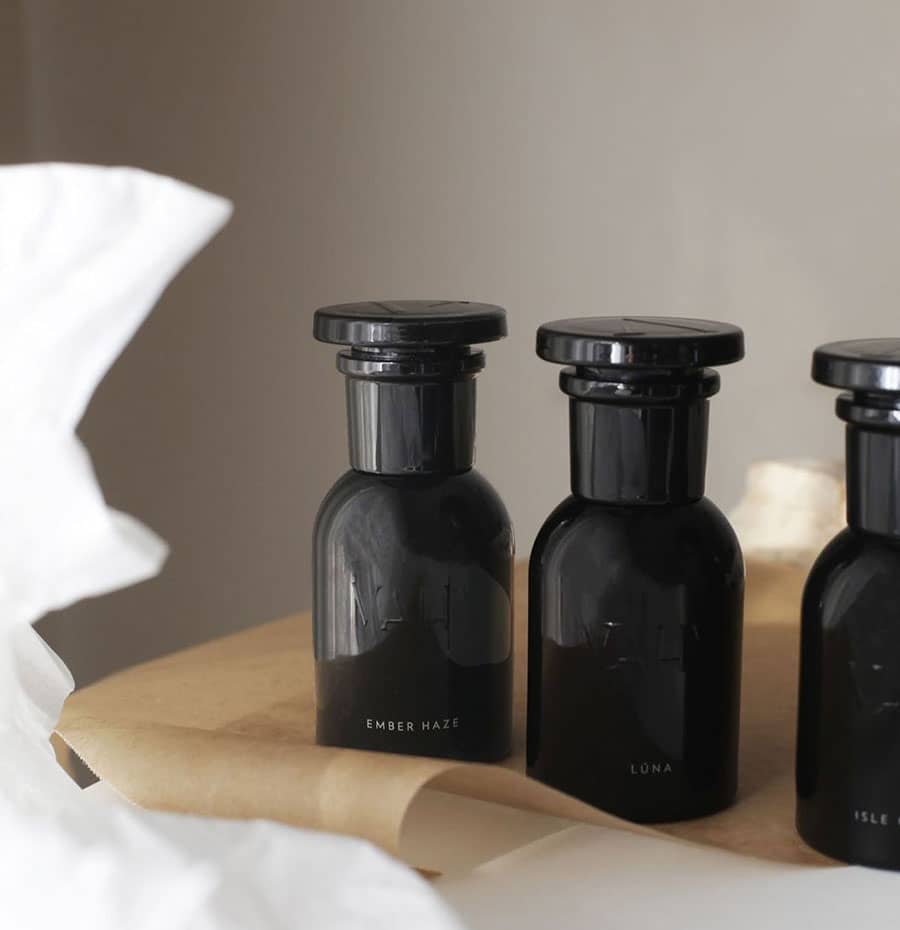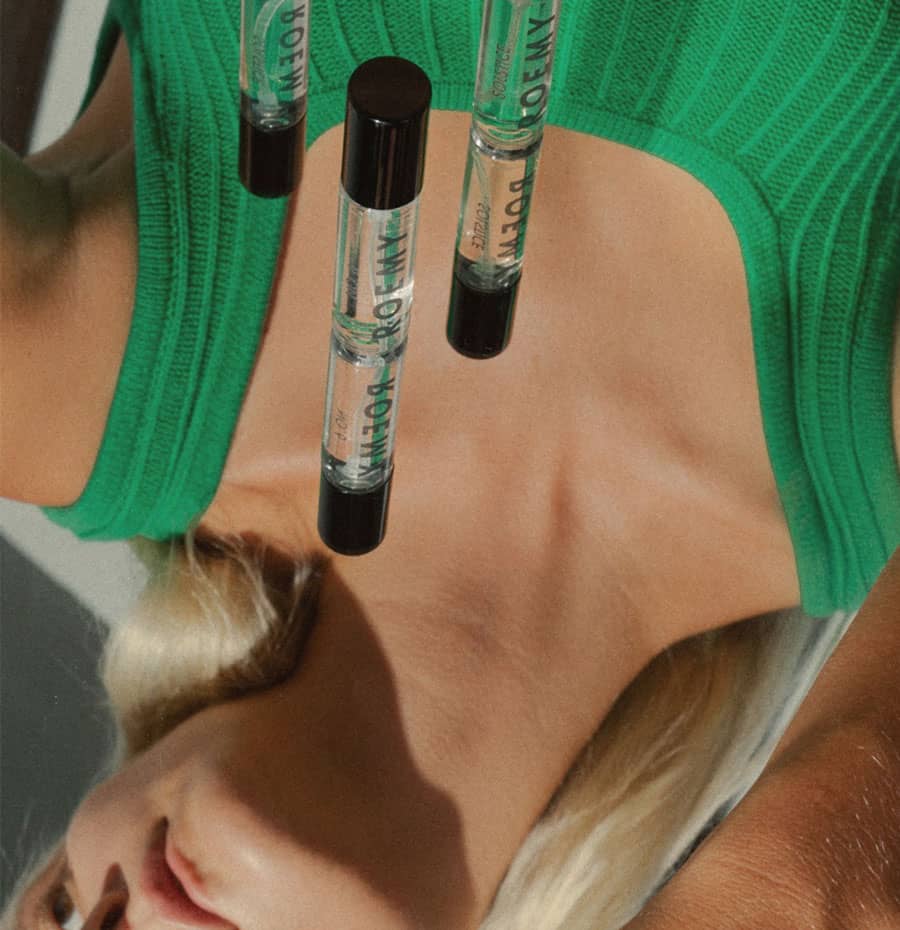-
-
-
-
-
Currency
beauty
The Fail-Proof Guide For Buying Perfume Online


Buying a new fragrance may seem like one of those things that you need to do IRL. But choosing a scent online can actually help you avoid some of the pitfalls of perfume shopping.
It turns out there’s a lot that can go wrong in a department store environment. First of all, using fragrance cards to test out perfumes does not give an accurate idea of how they interact with your skin (and therefore how they will truly smell for you). Skin type, pH levels, hormones and diet can all affect the final fragrance, which is why the same perfume will have a different bouquet for you and your bestie.
Outside aromas, like the coffee wafting in from the café next door and the disinfectant being used to clean the countertop, can also interfere with delicate scent profiles.
Even the bizarre practice of sniffing coffee beans between scents, which supposedly acts as a palate cleaner for the nose, isn’t enough to restore your ability to distinguish between patchouli and sandalwood after a certain point. So, in a lightheaded daze, you opt for the prettiest bottle and hope that it contains your new signature scent and not another bad match that will sit untouched on the bathroom counter.
“Buying a scent online is arguably better than buying it in a store for multiple reasons,” former New York Times scent critic Chandler Burr confirms. “The advantage of buying online is that you can read in quiet, sitting down, about the scent. You can read everything from the marketing copy to buyers’ comments, the history of the brand, and (for the hard-core perfume buyers) who the perfumers are.”
From the calm sanctuary of bed, it’s much easier to assess perfume preferences and figure out if a brand aligns with your values. This research will reveal important info, like whether that fruity fragrance contains petrochemicals and synthetic ingredients. And, if you’re armed with the right knowledge, it is possible to choose a scent that suits you without actually smelling it. Plus, there’s the added perk of not having to change out of your pyjamas.
If we’ve managed to convince you that buying perfume virtually is not only possible, but preferable, here’s everything else you need to know about buying your next scent online.
Look for full ingredient transparency
Look for full ingredient transparency
Opt for brands that disclose all the ingredients used to create their scents. This is especially important if you want to avoid the petroleum-based synthetics used in most popular perfumes, colognes and body sprays. When browsing online, look for natural ingredients and safe synthetics (made from nature-identical ingredients that have been approved by the IFRA) and avoid suspiciously short ingredient lists.
“You deserve to know what you’re putting on your pulse points,” Kate Macdonald, co-founder of natural perfume house Váhy, says. “If there is only “parfum/fragrance” and “denatured alcohol” listed along with the allergens that have to be mandatorily disclosed, you know you aren’t getting a true ingredient list.”
Both of the fragrance brands stocked on RIISE – Váhy and ROEMY – value transparency and extensively list the ingredients they avoid in their fragrances, including information about why they are harmful.
Know your notes

Documented By: @vahy.co
Know your notes
Before you even open your laptop, you will need to take an inventory of your perfume collection. Select a few of your favourite scents and review the fragrance notes. These are the scent layers that are combined to create a complete fragrance.
Top notes are the scents you smell immediately after the first spritz of perfume, they set the mood of the fragrance but evaporate within around 15 minutes (think citrus, ripe fruit, fresh flowers and herbs). Middle notes appear as the top notes begin to fade and act as the body of a fragrance, accounting for the majority of its final smell. They include long lasting and full-bodied scents such as jasmine, neroli and ylang-ylang. Base notes add depth and complexity. This is where you’ll find ingredients like sandalwood and musk.
“Scent preference is tied to memory so the fragrance notes that you like best will be deeply personal to you,” Kate explains. “Natural perfumes can have aromatherapy benefits, so I also pick a scent based on what my mood dictates; sandalwood and cedarwood based scents if I need calming, or bergamot and neroli notes to uplift and energise.”
Identify the notes that recur often in your perfume collection and go for something with a similar top, middle and base scent profile.
Try a sample kit

Documented By: Roemy
Try a sample kit
See if the brand offers any samples or mini versions to try out before you invest in the full-size. This will help you work out how each scent evolves on your skin over time. Wear scents in different environments to find “the one” for you.
Buy from a reputable source and be mindful of greenwashing
As Kate explains, brands often use terms like “green tech”, “non-toxic” and “clean ingredients” to market what she says are “essentially the same petrochemical derived synthetics that have been used in perfumery for decades [and] have not been tested for safety for human use”.
Purchasing from a reputable source, especially one that does the work of investigating and certifying any environmental claims for you, is the best way to avoid products containing potentially harmful ingredients. You can read more about our Climate Credential framework here if you want to understand how we measure a product’s environmental impact before listing it on the store.
Get acquainted with fragrance families, but don’t get too caught up in terminology
Get acquainted with fragrance families, but don’t get too caught up in terminology
Fragrances are organised into four main families – floral, fresh, woody and oriental. Oriental is an outdated and derogatory term that needs updating and, bizarrely, is the only category that doesn’t clearly denote a smell. It’s used to describe rich, spice-driven fragrances with notes of incense, cinnamon, vanilla and musk.
The floral and wood families are fairly self-explanatory, while fresh fragrances are dominated by the clean, bright notes of citrus, fruit, freshly cut grass and sea breeze. If this is all starting to feel a little esoteric, that’s because it is. The perfume industry is rife with overly descriptive language that, while important for categorising scents, can be confusing. Our advice is: don’t get too caught up on terminology when searching for a new scent, just focus on the key ingredients you know you love.
Phone a friend
When those flowery descriptions become a little too overwhelming, it’s always nice to get a read on a scent from a real person. Ask a friend to describe the fragrance in layman’s terms or do a deep dive through the product reviews. Someone once explained a perfume to me as “like biting into a crispy apple while sitting in a waterfall”, an oddly accurate summary that helped me understand exactly what I was in for.
Go beyond the ingredient list
As with any other purchase, buying a new fragrance is an opportunity to put your dollars towards the brands safeguarding our future. Read up on company policies and climate commitments before adding to cart. This will help you find “a scent and a brand that speaks to who you are as a person”, Kate explains.
Some questions she recommends asking are: “Does their ethos support what you support? Do they give back to the planet through charities? Do they source all of their ingredients sustainably?”

ABOUT US
CUSTOMER CARE
EDITORIAL & RIISE PRODUCTIONS
© 2024 RIISE, All Rights Reservedjoin riise's mailing list for 15% off your first order.Availability
















